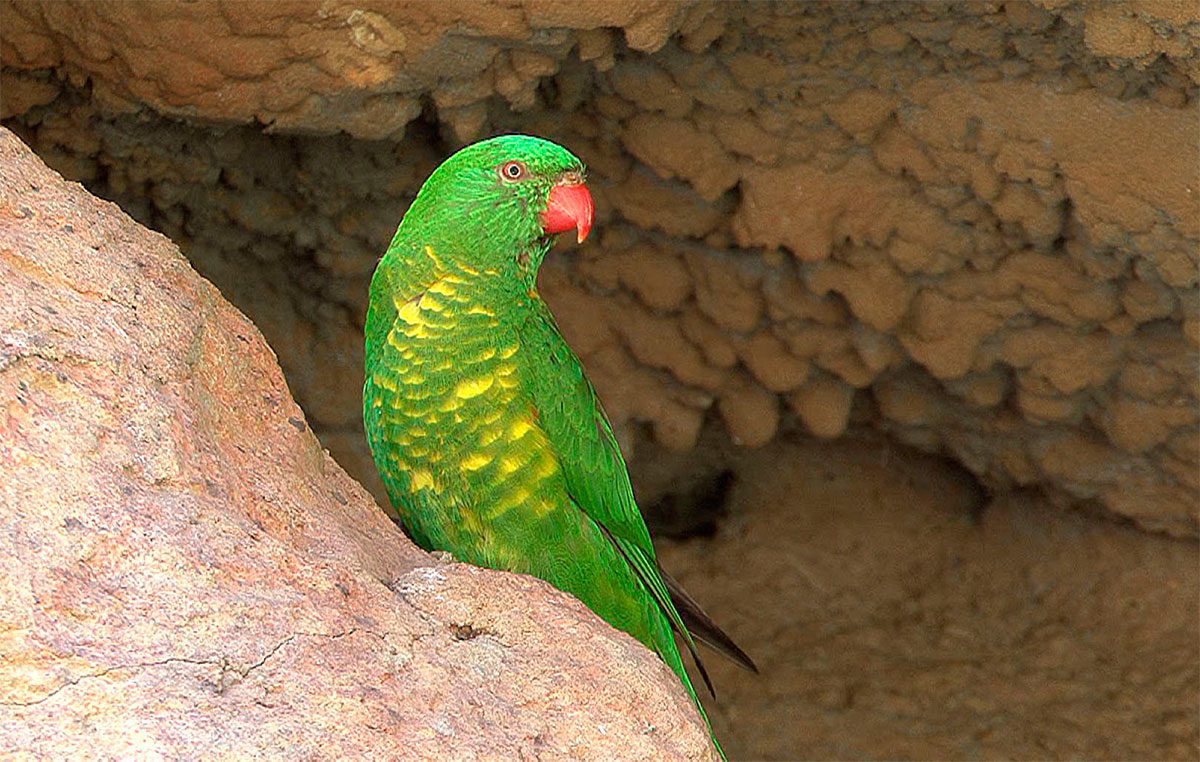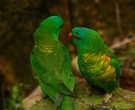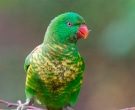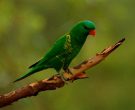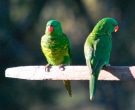Content |
|---|
Description
23 cm.. length and a weight between 75 and 95 gr.
The plumage of the Scaly breasted Lorikeet (Trichoglossus chlorolepidotus) is usually green.
The part back from your neck, the throat and the chest has several brands of yellow.
Under its tail, the the thighs and the sides of the body they are clearly marked with yellow.
Under its wing
, and more specifically by the part inferior of them flight feather, its color is reddish orange.
The circle around the eyes is narrow and grey. Its irises is yellowish-Orange. The legs are ash and the bill orange.
The immature are equal to adults, but with less scalloped yellow; the thighs Brown pale and tail shorter. The bill brown. The eye ring White grey.
- Sound of the Scaly breasted Lorikeet.
Habitat:
The Scaly breasted Lorikeet they are distributed by many forest habitats, including parks and Gardens located on the outskirts of cities and farmland, where are the flowering trees present.
They usually found in coastal areas and adjacent plateaus.
They have a strong preference for agricultural land and coastal scrub that are dominated by trees of the genus Banksia.
They can also be seen along the rivers, to the West of the Great dividing range. They can live up to 600 m.
The Scaly breasted Lorikeet they have quite similar patterns to the of the Coconut Lorikeet. It is not uncommon to find them together in mixed flocks where one of the two species generally outnumbers the other..
Most of the time, the Scaly breasted Lorikeet they live in pairs or in small groups of up to 10 individuals. They are most active at dawn, shortly after the dormitories are scattered.
They usually roam locally. These short trips are motivated by the search for food.
During flowering of trees, large groups may intervene if resources are abundant. The dispersion of groups is immediately after flowering.
In urban districts, are sedentary Since the sources of food are abundant in the gardens during all the year.
They are particularly friends of cultivated fruit, arriving to cause much damage in the orchards.
These birds have a flying fast and direct. When they are in the air they are immediately identifiable by its green head and bright orange red wings bass. When flying over the tops of them trees with rhythms fast, their wings produce a buzzing sound which is easily audible.
Reproduction:
The nesting season comprises of mayo to February in the North of the area of distribution, probably related to the decrease of rainfall.
In the southern part of the State of Victoria It takes place between August and January.
The Scaly breasted Lorikeet They nest in tree cavities, usually at a considerable height from the ground. They cover the bottom of the nest with a layer of sawdust and then lay two or three white eggs., oval in shape.
The incubation lasts a few 25 days. The male spends most of its time near hollow, but it does not seem to participate in the incubation. Both parents feed the chicks until they leave the nest, of 6 to 8 weeks after hatching.
Food:
The Scaly breasted Lorikeet they have a scheme rather similar to the of the Coconut Lorikeet. Both species feed primarily on nectar and pollen from the flowers especially the Niaouli (Melaleuca quinquenervia).
They feed also on flowers, berries, fruit, seeds, small insects and their larvae. Are big lovers of the fruits cultivated. They also enter sorghum and corn fields because they crave small immature milky grains..
Distribution:
Size of the area of distribution (reproduction / resident): 2.310.000 km2
The Scaly breasted Lorikeet being endemic to the Australian continent.
Its area of distribution extends from Bamaga in the extreme north of Queensland the District of Illawarra, on the South coast of New South Wales.
These birds are sedentary and abundant in the North, nomadic and less numerous in the South. They were introduced in the District of Melbourne, in the State of Victoria.
Conservation:
• Current IUCN Red List category: Least concern
• Population trend: Stable
The population World has not been quantified, but is estimated above 100.000 specimens.
The species is described as common in the center of its area of distribution and more rare toward the areas north and South of their area of distribution.
It is suspected that the population It stable in the absence of evidence of any reduction or substantial threats.
"Scaly breasted Lorikeet" in captivity:
Rare out of Australia; small number in the United States and the United Kingdom.
Gregarious, playful and loud. A bit messy due to a diet of nectar.
Its life in captivity ranges between 20 and 25 years.
Alternative names:
– Scaly breasted Lorikeet, Scalybreasted Lorikeet, Scaly-breasted Lorikeet (ingles).
– Loriquet vert, Loriquet à poitrine squameuse, Loriquet écaillé (French).
– Schuppenlori (German).
– Lóris-verde-de-peito-escamosos (Portuguese).
– Lori Escuamiverde, Tricogloso de Pecho Escamoso (español).

scientific classification:
– Order: Psittaciformes
– Family: Psittaculidae
– Genus: Trichoglossus
– Scientific name: Trichoglossus chlorolepidotus
– Citation: (Kuhl, 1820)
– Protonimo: Psittacus chlorolepidotus
Images “Scaly breasted Lorikeet”:
Videos "Scaly breasted Lorikeet"
——————————————————————————————————-
“Scaly breasted Lorikeet” (Trichoglossus chlorolepidotus)
Sources:
– Avibase
– BirdLife.org
– Parrots of the World – Forshaw Joseph M
– Parrots A Guide to the Parrots of the World – Tony Juniper & Mike Parr
– Photos:
– Josep de el Hoyo – IBC.lynxeds.com
– by Tobias Spaltenberger – Two Scaly-breasted Lorikeets at Taronga Zoo, Australia. – Wikimedia
– by Ken Havard – IBC.lynxeds.com
– by Aviceda – Wikipedia
– by Jeremy Eades – Wikipedia
– Sounds: Peter Woodall (Xeno-canto)
